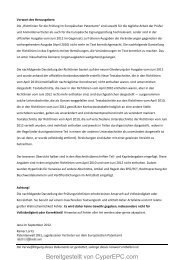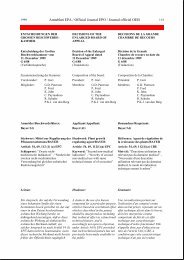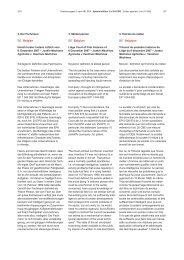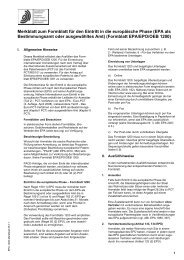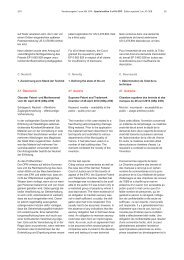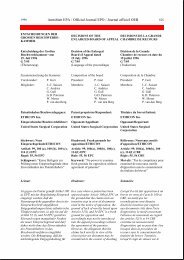Sonderausgabe 1 zum AB - CyberEPC
Sonderausgabe 1 zum AB - CyberEPC
Sonderausgabe 1 zum AB - CyberEPC
Create successful ePaper yourself
Turn your PDF publications into a flip-book with our unique Google optimized e-Paper software.
134 <strong>Sonderausgabe</strong> 1 <strong>zum</strong> <strong>AB</strong>l. EPA Special edition 1 of OJ EPO Edition spéciale 1 du JO OEB 2011<br />
auf ein Verfahren gerichteten Anspruch.<br />
Dementsprechend verletzten die Verkäufer<br />
das Patent durch den Verkauf des<br />
Erzeugnisses. Nach seiner Auffassung<br />
wurde der Anspruch jedoch durch eine<br />
Patentschrift vorweggenommen, in der<br />
dasselbe Material für einen anderen<br />
Zweck offenbart wurde, nämlich als<br />
Pauspapier oder als Tee- oder Tabakverpackung.<br />
Parker führte dazu aus:<br />
"Die Idee, ein altes Material zu einem<br />
völlig neuen Zweck zu verwenden, der<br />
mit seinem bisherigen Verwendungszweck<br />
nichts gemein hat, kann zwar<br />
durchaus patentierbar sein, würde aber,<br />
so erfinderisch sie auch sein mag, kaum<br />
einen Anspruch auf das Material selbst<br />
rechtfertigen."<br />
16. Der Patentinhaber beantragte indes<br />
natürlich kein Monopol auf die Folie<br />
selbst, sondern nur auf den Verkauf<br />
der Folie in einer bestimmten Absicht –<br />
ein beschränkter Sonderfall des durch<br />
einen Erzeugnisanspruch verliehenen<br />
Schutzes. Der Richter lehnte es ab, den<br />
Anspruch auf diese Weise zu betrachten,<br />
obwohl er es als erfinderisch wertete,<br />
eine neue Verwendung für ein bekanntes<br />
Erzeugnis zu finden. Nach dem damals<br />
geltenden Recht lag er damit zweifellos<br />
richtig – aber sind wir sicher, dass dieser<br />
Ansatz grundsätzlich der richtige ist?<br />
17. Sehr viel später musste sich das<br />
Patents Appeal Tribunal in Eli Lilly &<br />
Co's Application 5 mit einer Anmeldung<br />
für bekannte chemische Verbindungen<br />
befassen, für die neue und nützliche<br />
entzündungshemmende Wirkungen<br />
entdeckt worden waren. Der Anspruch<br />
sollte Folgendes schützen:<br />
"Die Herstellung, die Lieferung oder die<br />
Einfuhr von ... Verbindungen ... in der<br />
Absicht, diese als entzündungshemmende<br />
Wirkstoffe zu verwenden".<br />
18. Der betreffende Anspruch stellt eine<br />
interessante und kreative Anspruchsmischform<br />
dar. Ein Anspruch auf ein<br />
Erzeugnis verleiht dem Patentinhaber<br />
ein Monopol auf alle geschützten Handlungen.<br />
Der vorliegende Anspruch<br />
bedient sich einiger der Handlungen, die<br />
the product. However, on that view, the<br />
claim was anticipated by a specification<br />
which disclosed the same material for a<br />
different purpose: for tracing paper or for<br />
wrapping tea or tobacco. He said this:<br />
"The idea of using an old material for<br />
an entirely new purpose, not being<br />
analogous to purposes for which it has<br />
heretofore been used, may be good<br />
subject matter, but such idea, however<br />
ingenious, can hardly justify a claim for<br />
the material itself."<br />
16. But of course the patentee was not<br />
asking for a monopoly in the pellicle<br />
itself: only for a monopoly in selling the<br />
pellicle with a particular intention: a<br />
limited sub-class of the protection<br />
afforded by a product claim. The judge<br />
declined to see the claim in that way,<br />
notwithstanding the fact that he saw<br />
inventiveness in finding a new use for a<br />
known product. He was no doubt right<br />
under the law as it then was – but are<br />
we sure that is the right approach in<br />
principle?<br />
17. More recently, in Eli Lilly & Co's<br />
Application 5 the Patents Appeal Tribunal<br />
was faced with an application for known<br />
chemical compounds for which new and<br />
valuable anti-inflammatory effects had<br />
been discovered. The claim sought<br />
protection for:<br />
"The manufacture, supply or importation<br />
of ... compounds ... intending the same<br />
to be used as anti-inflammatory agents".<br />
18. The claim is an interesting and imaginative<br />
hybrid type of claim. A claim to a<br />
product gives the patentee a monopoly<br />
in all the prohibited acts. This claim uses<br />
some of the prohibited acts normally<br />
granted in respect of product claims,<br />
manufacture, supply and importation,<br />
différent de la première revendication qui<br />
est une revendication de procédé. Les<br />
vendeurs ont donc contrefait l'invention<br />
en vendant le produit. Néanmoins, si l'on<br />
adopte ce point de vue, la revendication<br />
est antériorisée par une spécification qui<br />
divulgue le même matériau mais pour<br />
une finalité différente : fabriquer du<br />
papier-calque ou pour emballer du thé<br />
ou du tabac. Le juge s'est exprimé en<br />
ces termes :<br />
"L'idée d'utiliser un matériau ancien à<br />
une fin complètement nouvelle n'ayant<br />
pas de rapport avec les finalités pour<br />
lesquelles ce matériau avait été utilisé<br />
jusqu'ici, est peut-être quelque chose<br />
d'intéressant, mais cette idée, aussi<br />
ingénieuse soit-elle, ne peut guère<br />
constituer le fondement d'une revendication<br />
portant sur le matériau lui-même."<br />
16. Le titulaire du brevet ne demandait<br />
bien évidemment pas de bénéficier d'un<br />
monopole sur la pellicule elle-même,<br />
mais d'un monopole sur la vente de la<br />
pellicule dans une intention spécifique :<br />
une sous-catégorie limitée de la protection<br />
assurée par une revendication de<br />
produit. Le juge n'a pas voulu considérer<br />
la revendication sous cet angle-là,<br />
malgré qu'il ait estimé qu'il y avait de<br />
l'inventivité à trouver une nouvelle utilisation<br />
à un produit connu. Le juge avait<br />
incontestablement raison du point de<br />
vue du droit tel qu'il était à ce moment-là,<br />
mais sommes-nous certains que c'est la<br />
bonne approche en principe ?<br />
17. Plus récemment, dans l'affaire Eli<br />
Lilly & Co's Application 5 , la Cour d'appel<br />
en matière de brevets avait à traiter une<br />
demande de brevet portant sur des<br />
composés chimiques connus pour<br />
lesquels on avait découvert de nouveaux<br />
effets anti-inflammatoires présentant une<br />
certaine valeur. La revendication sollicitait<br />
la protection d'un brevet pour :<br />
"la production, la fourniture ou l'importation<br />
de ... composés ... dans l'intention<br />
d'utiliser ces composés comme agents<br />
anti-inflammatoires".<br />
18. Cette revendication est intéressante.<br />
C'est un type hybride et imaginatif de<br />
revendication. Une revendication de<br />
produit confère habituellement au titulaire<br />
du brevet le monopole de tous les<br />
actes interdits aux tiers. La revendication<br />
dans l'affaire Eli Lilly prend pour base<br />
5 [1975] RPC 438. 5 [1975] RPC 438. 5 [1975] RPC 438.



